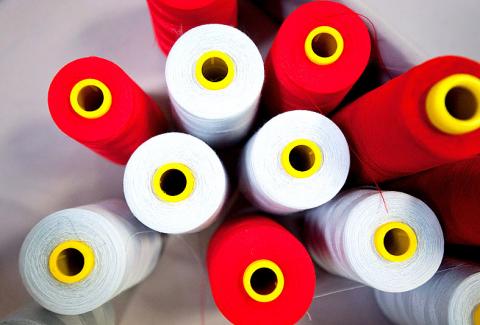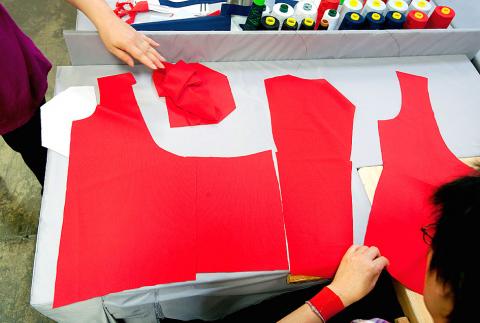Function and fashion must blend seamlessly in modern workout clothes, which have come a long way from the bulky gray cotton sweatshirts and canvas sneakers of years past, fitness experts say.
From sophisticated sweat-absorbing synthetics to cycling pants with strategically placed padding, today’s exercise apparel must be durable enough to withstand a hardcore workout, stylish enough to meet friends or run errands, and distinct enough to let the world know who you are.
Chris Froio, head of training for Reebok International Ltd, the running shoe and apparel company, said consumers of both sexes are expecting their clothes not only perform but express the fitness lifestyle of the wearer.

Photo: Bloomberg/ Noah Berger
“What you see is: ‘Yes, I need my functional clothing, but I also need to look good going to and from the gym and picking up the kids,” said Froio. “’I need the style and comfort that’s going to let me wear it all day.’”
Froio said customers aren’t looking just for function or just for style, they are demanding a blend.
The world sports apparel industry is expected to exceed US$126 billion in sales by 2015, according to a 2013 report by Global Industry Analysts, a market research firm.

Photo: Bloomberg/ Noah Berger
Froio cites the ubiquity of running shoes being worn by non-runners and notes that teenagers appear to be favoring leggings, yoga pants and other athletic styles.
Bold colors, prints and graphics have gone from the periphery to a fashionable mainstay, Froio said, as exercisers look for clothes that communicate as well as perform.
“People want something that conveys the attitude of the wearer, that allows them to express themselves, whether through a colorful headband or by revealing their tattoos,” he said.
Functionality, starting with lightweight, durable, breathable fabrics with enough stretch to cover the exerciser’s full range of motion, has evolved with the help of technology imported from other industries.
“We have cooling technologies developed from the aerospace industry,” Froio said. “From cookware we have (developed) the Teflon applied to running wear to keep rain off athletes.”
Miami-based trainer Jessica Smith said the new fabrics hold out the dual promise of making the wearer look good and improving performance as well.
“We have compression materials, supportive materials, fabrics that breathe and give,” said Smith, creator of the Walk On fitness DVDs. “Also, you’ll see a difference between yoga clothing and clothing designed for running.”
Design becomes more functional as science becomes more sophisticated, she said, from pockets for cellphones to anti-bacterial wicking that claims to keep the exerciser not only dry but odor-free.
“We’re seeing colorful and decorative compression socks that help Olympic power lifters avoid shin burns (from chafing barbells),” she said.
Clothes have become more sophisticated, said Jessica Matthews, an exercise physiologist at Miramar College in California.
“Fitness apparel has evolved in the quality of material and the quality of construction,” she said.
Trends in general fashion bleed steadily into fitness apparel, Matthews said, though not always with the most functional of outcomes.
“I remember a few years ago a trend towards low-waisted yoga pants ... not the best choice for the curvier among us,” she said.

The canonical shot of an East Asian city is a night skyline studded with towering apartment and office buildings, bright with neon and plastic signage, a landscape of energy and modernity. Another classic image is the same city seen from above, in which identical apartment towers march across the city, spilling out over nearby geography, like stylized soldiers colonizing new territory in a board game. Densely populated dynamic conurbations of money, technological innovation and convenience, it is hard to see the cities of East Asia as what they truly are: necropolises. Why is this? The East Asian development model, with

June 16 to June 22 The following flyer appeared on the streets of Hsinchu on June 12, 1895: “Taipei has already fallen to the Japanese barbarians, who have brought great misery to our land and people. We heard that the Japanese occupiers will tax our gardens, our houses, our bodies, and even our chickens, dogs, cows and pigs. They wear their hair wild, carve their teeth, tattoo their foreheads, wear strange clothes and speak a strange language. How can we be ruled by such people?” Posted by civilian militia leader Wu Tang-hsing (吳湯興), it was a call to arms to retake

This is a deeply unsettling period in Taiwan. Uncertainties are everywhere while everyone waits for a small army of other shoes to drop on nearly every front. During challenging times, interesting political changes can happen, yet all three major political parties are beset with scandals, strife and self-inflicted wounds. As the ruling party, the Democratic Progressive Party (DPP) is held accountable for not only the challenges to the party, but also the nation. Taiwan is geopolitically and economically under threat. Domestically, the administration is under siege by the opposition-controlled legislature and growing discontent with what opponents characterize as arrogant, autocratic

Desperate dads meet in car parks to exchange packets; exhausted parents slip it into their kids’ drinks; families wait months for prescriptions buy it “off label.” But is it worth the risk? “The first time I gave him a gummy, I thought, ‘Oh my God, have I killed him?’ He just passed out in front of the TV. That never happens.” Jen remembers giving her son, David, six, melatonin to help him sleep. She got them from a friend, a pediatrician who gave them to her own child. “It was sort of hilarious. She had half a tub of gummies,